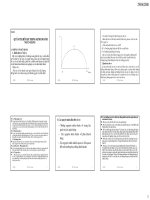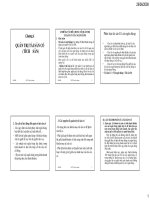slike bài giảng quản trị ngân hàng chương 8 risk management for changing interest rates
Bạn đang xem bản rút gọn của tài liệu. Xem và tải ngay bản đầy đủ của tài liệu tại đây (4.28 MB, 69 trang )
William Chittenden edited and updated the PowerPoint slides for this edition.
RISK MANAGEMENT FOR
CHANGING INTEREST RATE:
ASSET-LIABILITY
MANAGEMENT DURATION
Chapter 8
Key topics
1. Asset, Liability, and Funds management
2. Market rates and interest-rate risk
3. The goals of interest-rate hedging
4. Interest-sensitive gap management
5. Duration gap management
6. Limitations of hedging techniques
7-2
Asset-Liability Management
The purpose of Asset-Liability management is to
control a bank’s sensitivity to changes in market
interest rates and limit its losses in its net income or
equity.
7-3
Asset and Liability Management
Committee (ALCO)
The ALCO’s primary responsibility is interest rate
risk management.
The ALCO coordinates the bank’s strategies to
achieve the optimal risk/reward trade-off.
Historical view of asset-liability
management
Asset management strategy (control over assets, no
control over liabilities)
Liability management strategy (control over
liabilities by changing rates and other terms)
Funds management strategy (work with both
strategies)
7-5
Interest rate risk:
one of the main challenges
Forces determining interest rates
Loanable funds theory
The measurement of interest rates
YTM
Bank discount
Components of interest rates
7-6
Yield to maturity (YTM)
∑
=
+
=
n
1t
t
t
YTM) (1
CF
PriceMarket
7-7
Bank discount rate (DR)
Maturity toDays #
360
*
FV
Price Purchase- FV
DR =
Where: FV equals Face Value of a Security,
such as Treasury Bills
7-8
Market interest rates
Function of:
Risk-free real rate of interest
Various risk premiums
Default risk
Inflation risk
Liquidity risk
Call risk
Maturity risk
7-9
Yield curves
Graphical picture of relationship between yields and
maturities on securities
Generally created with treasury securities to keep
default risk constant
Shape of the yield curve
Upward – long-term rates higher than short-
term rates
Downward – short-term rates higher than long-
term rates
Horizontal – short-term and long-term rates the
same
Shape of the yield curve and a maturity gap
7-10
Net interest margin
Assets Earnings Total
ExpensesInterest - IncomeInterest
NIM =
7-11
Goal of interest rate hedging
One important goal of interest rate hedging is to
insulate the bank from the damaging effects of
fluctuating interest rates on profits.
7-12
Quick quiz
1. What forces cause interest rates to change?
2. What makes it so difficult to correctly forecast
interest rate changes?
3. What is the yield curve, and why is it important to
know about its shape and slope?
4. What is the goal of hedging?
•
First National Bank of Bannerville has posted interest revenues of
$63 million and interest costs from all of its borrowings of $42
million. If this bank possesses $700 million in total earning assets,
what is First National’s net interest margin? Suppose the bank’s
interest revenues and interest costs double, while its earning assets
increase by 50%. What will happen to its net interest margin?
7-13
Interest rate risk
Interest rate risk
The potential loss from unexpected changes in
interest rates which can significantly alter a
bank’s profitability and market value of equity.
Interest rate risk
Reinvestment risk
When interest rates fall, the coupon payments
on the bond are reinvested at lower rates
Price risk
When interest rates rise, the market value of the
bond or asset falls
7-15
Interest rate risk:
Re-investment rate (spread) risk
If interest rates change, the bank will have to
reinvest the cash flows from assets or refinance
rolled-over liabilities at a different interest rate in the
future.
An increase in rates, ceteris paribus,
increases a bank’s interest income but also
increases the bank’s interest expense.
Static GAP Analysis considers the impact of
changing rates on the bank’s net interest income.
Interest rate risk:
Price risk
If interest rates change, the market values of assets
and liabilities also change.
The longer is duration, the larger is the
change in value for a given change in
interest rates.
Duration GAP considers the impact of changing
rates on the market value of equity.
Measuring interest rate risk with GAP
Example:
A bank makes a $10,000 four-year car loan to a
customer at fixed rate of 8.5%. The bank initially
funds the car loan with a one-year $10,000 CD at
a cost of 4.5%. The bank’s initial spread is 4%.
What is the bank’s risk?
What determines rate sensitivity (ignoring
embedded options)?
An asset or liability is considered rate sensitivity if
during the time interval:
It matures
It represents and interim, or partial, principal
payment
It can be repriced
The interest rate applied to the outstanding
principal changes contractually during the interval
The outstanding principal can be repriced when
some base rate of index changes and
management expects the base rate / index to
change during the interval
What are RSAs and RSLs?
Considering a 0-90 day “time bucket,” RSAs and RSLs
include:
Maturing instruments or principal payments
If an asset or liability matures within 90 days, the
principal amount will be re-priced
Any full or partial principal payments within 90
days will be re-priced
Floating and variable rate instruments
If the index will contractually change within 90
days, the asset or liability is rate sensitive
The rate may change daily if their base rate
changes.
Issue: do you expect the base rate to change?
Examples of re-priceable (interest sensitive)
Assets and Liabilities
7-21
Factors affecting net interest income (NII)
Changes in the level of interest rates
Changes in the spread between assets and liabilities
Changes in the rate sensitive gap (= RSA – RSL),
caused by
Changes in the composition of assets and liabilities
Changes in the volume of earning assets and
interest-bearing liabilities outstanding
Factors affecting net interest income:
An example
Consider the following balance sheet:
Examine the impact of the following changes
A 1% increase in the level of all short-term rates?
A 1% decrease in the spread between assets yields
and interest costs such that the rate on RSAs
increases to 8.5% and the rate on RSLs increase to
5.5%?
A proportionate doubling in size of the bank?
A change in the composition of both assets and
liabilities
1% increase in short-term rates
With a negative GAP, more
liabilities than assets reprice
higher; hence NII and NIM fall









